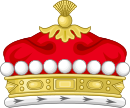Line of succession
-
 Alan Tindal Lennox-Boyd, 1st Viscount Boyd of Merton (1904–1983)
Alan Tindal Lennox-Boyd, 1st Viscount Boyd of Merton (1904–1983)-
 Simon Donald Rupert Neville Lennox-Boyd, 2nd Viscount Boyd of Merton (born 1939)
Simon Donald Rupert Neville Lennox-Boyd, 2nd Viscount Boyd of Merton (born 1939) - (1)Hon. Benjamin Alan Lennox-Boyd (born 1964)
- (2) Alan George Simon Lennox-Boyd (born 1993)
- (3) Arthur Rupert George Lennox-Boyd (born 2021)
- (4) Rupert Simon David Lennox-Boyd (born 2025)
- (5) Henry Simon Lennox-Boyd (born 1997)
- (2) Alan George Simon Lennox-Boyd (born 1993)
- (6)Hon. Edward George Clive [a] (born 1968)
- (7) Jago George Antony Clive (born 1997)
- (8) William Enys Clive (born 1998)
- (1)Hon. Benjamin Alan Lennox-Boyd (born 1964)
-


